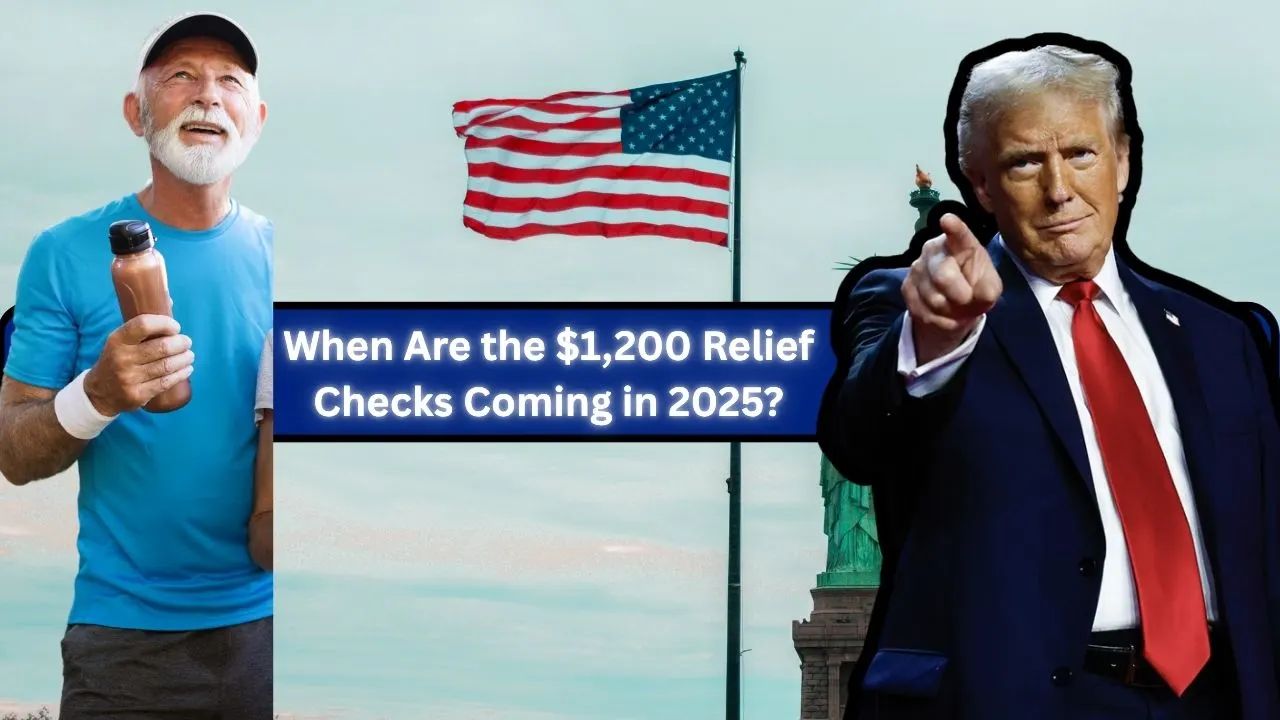The prospect of $1,200 relief checks in 2025 has sparked widespread interest among Americans facing ongoing economic challenges. Fueled by rising inflation, increasing living costs, and social media buzz, rumors of new federal stimulus payments have gained traction. However, as of June 12, 2025, no official federal program confirms the distribution of $1,200 relief checks. This article examines the status of these rumored payments, explores their origins, clarifies eligibility and potential timelines, and outlines existing financial support options for Americans in 2025.
The Context of Relief Checks in 2025
The idea of $1,200 relief checks echoes the Economic Impact Payments (EIPs) issued during the COVID-19 pandemic under the CARES Act (2020), which provided up to $1,200 per adult, and subsequent rounds in 2020 and 2021. These payments aimed to alleviate financial strain from pandemic-related disruptions. In 2025, economic pressures persist, with inflation at 2.4% in May 2025, above the Federal Reserve’s 2% target, and costs for essentials like food (up 5% year-over-year) and housing continuing to squeeze budgets, according to the Bureau of Labor Statistics.
Social media platforms like X and unverified websites have amplified claims of $1,200 federal relief checks, often citing vague government initiatives or misrepresenting state-level programs. For instance, a December 2024 post on NewsBreak suggested $1,200 direct deposits were forthcoming, but the IRS has not confirmed such a program. Similarly, LKO Uniexam.in claimed payments would begin April 15, 2025, based on 2024 tax returns, yet no federal legislation supports this. These rumors likely stem from confusion with state initiatives, like California’s $725 Family First Economic Support Program (FFESP), or misinterpretations of prior stimulus efforts.
Why No $1,200 Federal Relief Checks in 2025?
Several factors make a new $1,200 federal relief check unlikely in 2025:
-
Economic Policy Priorities: The Federal Reserve’s focus on controlling inflation through steady interest rates, as confirmed in its June 18, 2025, meeting, reduces the likelihood of stimulus payments that could increase consumer spending and fuel inflation. The Congressional Budget Office projects a $1.9 trillion federal deficit, limiting funds for large-scale relief without new legislation.
-
No Legislative Support: Unlike the CARES Act or American Rescue Plan, which authorized previous EIPs, no 2025 federal bill proposes $1,200 checks. Proposals like the DOGE dividend checks remain conceptual, lacking Congressional approval. Political focus, as reported by Reuters, centers on trade negotiations and immigration, not domestic stimulus.
-
Existing Benefits: Ongoing programs like Social Security ($1,950.27 average monthly payment in June 2025), Supplemental Security Income (SSI, up to $967), and the Earned Income Tax Credit (EITC, up to $7,830) provide financial support, reducing the need for one-off payments. The IRS also concluded its distribution of unclaimed 2021 Recovery Rebate Credits (RRCs) by April 15, 2025, with $2.4 billion sent to 1 million taxpayers.
-
Misinformation Risks: False claims about $1,200 checks often originate from unreliable sources. A 2024 yuvagalam.com post suggested payments were imminent, but the IRS debunked this, urging reliance on official channels like IRS.gov. Scammers exploit these rumors, phishing for personal details with fake “claim your payment” schemes.
What About State-Level Relief?
While federal $1,200 checks are unconfirmed, several states are offering relief in 2025, which may be confused with federal programs:
-
Alaska: The 2025 Permanent Fund Dividend (PFD) pays $1,702 to eligible residents, funded by oil revenue. Eligibility requires living in Alaska for the full prior year and no felony convictions. Payments begin in October 2025, not June, and are unrelated to federal stimulus.
-
California: The FFESP provides $725 monthly to 200 low-income families in specific Sacramento ZIP codes until November 2025. This targeted program, funded by the California Department of Social Services, focuses on Black and Native American families with children under 5, sparking debate over its eligibility criteria.
-
Colorado: The Taxpayer’s Bill of Rights (TABOR) refund distributes up to $565 for single filers and $1,130 for joint filers in 2025, based on a $1.5 billion surplus. Payments depend on adjusted gross income (AGI) and are issued after tax filing.
-
Virginia: Lawmakers are debating $200–$400 rebates for 2024 filers versus a $1.1 billion car tax credit. No final decision has been made, but payments, if approved, would likely start post-June 2025.
These state programs vary in scope and eligibility, contributing to confusion with rumored federal checks. Always check state government websites for accurate details.
Alternative Federal Support in 2025
Americans can access several federal and local programs in lieu of $1,200 checks:
-
Social Security and SSI: Payments are scheduled by birth date (e.g., June 11 for those born 1st–10th), with averages of $1,950.27 for Social Security and $967 for SSI individuals. These adjust annually for inflation, providing steady support.
-
Earned Income Tax Credit (EITC): Low-income workers can claim up to $7,830 for families with three or more children, based on 2024 tax returns. Filing by April 15, 2025, ensures timely refunds, often arriving by summer.
-
Low Income Home Energy Assistance Program (LIHEAP): Grants help cover cooling and heating costs, critical in summer 2025. Contact state LIHEAP offices for eligibility.
-
Supplemental Nutrition Assistance Program (SNAP): Provides about $180 per person monthly for food, adjusted for inflation. Apply through state agencies.
-
Child Tax Credit (CTC): For 2025, the CTC offers up to $2,000 per child under 17, with $1,600 refundable. Unlike 2021’s advance payments, it’s claimed via tax returns.
Preparing for Potential Payments
If $1,200 checks were approved, preparation would mirror past EIPs:
-
File Taxes Promptly: Eligibility would likely depend on 2024 tax returns, with income thresholds like $75,000 (single) or $150,000 (joint). Update your IRS account at IRS.gov.
-
Update Banking Details: Direct deposits are fastest, using the bank account on your latest return. Ensure details are current to avoid delays.
-
Check IRS Tools: The “Get My Payment” tool, if reactivated, would track payment status. Monitor IRS.gov for updates.
-
Avoid Scams: Ignore unsolicited requests for personal information. The IRS never initiates contact via text or email for payments.
Addressing Misinformation
The $1,200 rumor highlights the dangers of misinformation. A 2024 NewsBreak article falsely claimed payments were set for 2024, citing no official source. Similarly, yuvagalam.com’s 2025 claim lacked IRS backing. To verify:
-
Check IRS.gov or SSA.gov for announcements.
-
Consult trusted news outlets like NPR or CNBC.
-
Report scams to ReportFraud.ftc.gov.
Misinformation can delay access to real aid, as families may wait for nonexistent checks instead of applying for SNAP or LIHEAP.
Economic Impact and Outlook
If $1,200 checks were issued, they could reduce poverty, as seen in 2021 when stimulus payments lifted 11.7 million Americans out of poverty, per the U.S. Census Bureau. However, the National Bureau of Economic Research notes 80% of such funds are spent within three months, potentially fueling inflation. With trade tensions and a 2.3% global growth forecast for 2025 (World Bank), the government prioritizes fiscal restraint over broad stimulus.
FAQs
1. Are $1,200 relief checks confirmed for 2025?
No, there is no federal confirmation of $1,200 relief checks for 2025. Rumors stem from misinformation or confusion with state programs like California’s $725 FFESP or Alaska’s $1,702 PFD. Check IRS.gov for updates.
2. What should I do if I hear about $1,200 checks?
Verify claims through IRS.gov or SSA.gov. Avoid sharing personal details with unsolicited messages claiming to offer payments. Report fraud to ReportFraud.ftc.gov.
3. What financial help is available in June 2025?
Social Security ($1,950.27 average), SSI ($967 max), EITC (up to $7,830), SNAP, and LIHEAP offer support. State programs like Colorado’s TABOR refund ($565–$1,130) may also apply.
4. How can I prepare for potential relief checks?
File your 2024 tax return by April 15, 2025, update banking details with the IRS, and monitor IRS.gov for announcements. Ensure your address is current for mailed payments.
Looking Forward
As of June 12, 2025, $1,200 federal relief checks remain unconfirmed, with no legislative or IRS backing. Economic constraints, existing benefits, and misinformation explain their absence. Americans can rely on Social Security, SSI, EITC, and state programs like Alaska’s PFD or California’s FFESP for support. To stay prepared, file taxes promptly, update IRS records, and verify claims through official sources. By focusing on legitimate aid and avoiding scams, households can navigate 2025’s economic challenges effectively.

